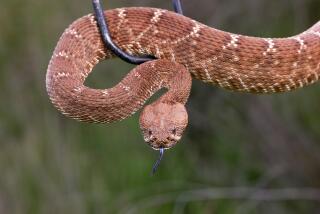Sidewinder snake helps engineers design a better robot [VIDEO]

A team led by Georgia Tech researchers tests sidewinder snakes, both real and robotic, to learn how they move on a sandy surface.
If a future Mars rover plans to climb up something steep, it might have to look something like a sidewinder snake.
These rattlesnakes have an unusual way of moving across sandy surfaces, and engineers have been trying to replicate it. If they succeed, they say, they could make robots capable of conducting search and rescue operations on Earth or exploring other planets in the solar system.
Now, for the first time, they have created a mechanical serpent capable of crawling up dunes. A team led by researchers from the Georgia Institute of Technology described their project this month in the journal Science.
Snakes never let a lack of legs keep them down. These limbless reptiles can climb trees, swim and even glide through the air, depending on the species.
But simply moving on the ground can present some challenges — particularly if that ground is covered with sand, a granular substrate that’s made of tiny solids but moves like a fluid. (Anybody who has tried running on the dry sand on a beach knows how difficult it can be.)
The sidewinder, known formally as Crotalus cerastes, has mastered the art of traversing the sandy deserts of the Southwestern United States and northwestern Mexico. Its zigzagging body sidles across hot deserts, using the “zig” segments of its curving body for purchase as it lifts up the “zag” segments. This distinctive motion is quite different from the comparatively straightforward slither of your typical snake.
“It’s a crazy-looking gait,” said Georgia Tech physicist Daniel Goldman, the senior author of the Science study. “There are field biologists who’ve studied these animals, and they say if you look at sidewinding too long, you’ll go mad.”
Researchers have long tried to build snake-like robots. One such robot was deployed on an archaeological mission to search ancient Egyptian caves thought to hold artifacts that were thousands of years old. But the robot, called Elizabeth, slipped and pitched over on a sandy slope.
“It was very sad,” said Howie Choset, the roboticist at Carnegie Mellon University in Pittsburgh who built Elizabeth. “You want your robot to work well.”
So Choset teamed up with Goldman to see whether a robotic snake could help them understand how sidewinders move. If so, they figured, they might be able to improve their robot in the process.
The researchers went to the Yuma Desert in Arizona to find sidewinder rattlesnakes to study. They also collected desert sand to make sure the snakes would be traversing natural terrain.
The animals and the sand were brought to a modest shed in the back of Zoo Atlanta.
“The snakes were quite venomous, and we were not allowed to bring them to Georgia Tech,” Goldman explained.
At the zoo, the researchers built a simulated sand dune test apparatus to watch the snakes move on both flat and slanted surfaces.
The scientists found that the sidewinders managed to move across inclines as high as 20 degrees. To do so, they employed a neat trick: they lengthened the “zig” segments of their bodies that were in contact with the sand. That allowed them to move without getting stuck.
When the engineers incorporated this insight into the software controlling the robot snake, the robot was able to handle sandy inclines that before would have left it wriggling helplessly.
And when the researchers ran 13 other pit viper species through the gantlet to see whether they could traverse the sand, they writhed to no effect. They lacked the neural “software” to adopt the sidewinder’s expert gait — and unlike the robot, they couldn’t get an upgrade.
“That was really surprising,” said Jake Socha, a biomechanist at Virginia Tech who was not involved in the study. “What that’s telling us is that the program to be able to sidewind is something that is not inherent in every snake species.”
The researchers say they are excited about how the robot will help them understand the way snakes move in real life, and about the insight the snakes will provide to help them build a better, more agile robot. It’s mutually beneficial for biology and engineering, Goldman said.
The robot isn’t just an end product of studying nature: It’s also a tool to better understand nature.
Socha, who studies the relationship between form and function in animals — including flying snakes — agreed.
“It was actually pretty incredible,” he said. “What was striking about it was how well they crossed from animal experiments to robotic experiments to physical experiments, and they all informed each other. ... It was all really nicely intertwined.”
Want your own robot snake? Follow @aminawrite for more fascinating science news.







